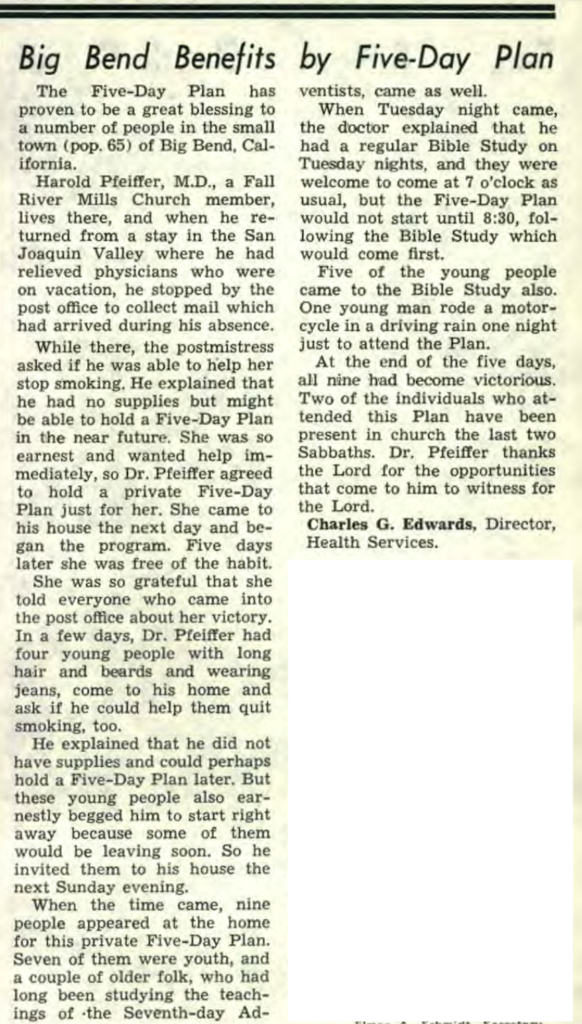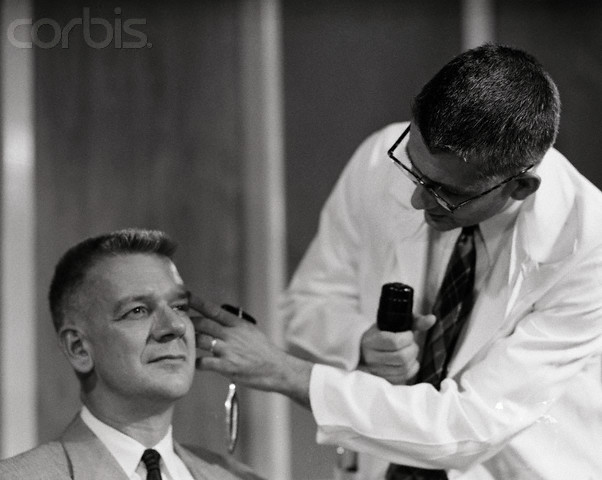The Shire Springs property is located in Madesi Territory and is part of the land that was stolen by white settlers from the Madesi tribal lands in the 1800s, when colonialist settlers of European descent moved into the valley and formed the town that is now known as Big Bend. The town was formerly called “Elena,” apparently named after the first female white settler who lived in Big Bend. Later, the town was renamed “Henderson,” named after a prominent family of local settlers, before being renamed again to Big Bend.
In the 1950s and 1960s, Dr. Harold Pfeiffer owned the land that is now called the Shire (also known as “Shire Springs”), along with several other properties in Big Bend. Dr. Pfeiffer was a family physician in Big Bend, and supposedly helped local nicotine addicts quit smoking.


The Five-Day Plan to Quit Smoking is one of the oldest and most effective smoking cessation programs to date. First published by J. Wayne McFarland, M.D. and Elman J. Folkenberg in 1964, the Five-Day Plan has gone on to be conducted in countries around the world with over 20 million participants. The plan has also received recognition from the World Health Organization, the American Cancer Society, the American Lung Association, and the American Heart Association.
This program takes participants through a five-day step-by-step program to change daily habits and achieve their goal to quit smoking. Through psychological motivations (such as affirmation statements) and physical changes (such as dietary modifications and a comprehensive physical fitness program for the total health of your body, mind, and spirit), the Five-Day Plan works to break the participant’s smoking routine and eliminate cigarette cravings. The plan also addresses issues such as weight gain and symptoms associated with nicotine withdrawal, along with alternative activities to overcome such concerns and remain smoke-free.
In more modern times, there were rumors that Dr. Pfeiffer of Big Bend was an early experimenter with LSD, before it was made illegal in 1969. The rumors proved to be false, as it was actually apparently Dr. Pfeiffer’s brother, Carl, a pharmacologist, who was the Dr. Pfeiffer who was known to have experimented with LSD in the 1950s. Dr. Carl Pfeiffer apparently never lived in Big Bend, but was an early LSD researcher, who used the medicine (still legal and relatively unknown at the time) to try to better understand schizophrenia (see pictures and captions below, from the U.S. Library of Congress).
History of LSD:
https://en.wikipedia.org/wiki/History_of_lysergic_acid_diethylamide
27 Nov 1955, Atlanta, Georgia, USA — Original caption: Dr. Harry L. Williams (left) administers LSD 25 (lysergic acid diethylamide) to Dr. Carl Pfeiffer, chairman of Emory University’s Pharmacological Department, to produce effects similar to those experienced by schizophrenics. The new drug is being used in experiments to find out more about the inner feelings of the mentally ill and to discover whether a chemical disorder is responsible for mental illnesses. The microphone (foreground) was used to interview Dr. Pfeiffer during his journey through lunacy. — Image by © Bettmann/CORBIS


27 Nov 1955, Atlanta, Georgia, USA — Original caption: Dr. Harry L. Williams (right) examines the eyes of Dr. Carl Pfeiffer after administering LSD 25, the new drug which produces effects similar to those experienced by schizophrenics. One of the first reactions was dilation and contraction of the pupils with no relation to light conditions. After about an hour he began to experience inner trembling and anxiety. It was one of many tests being made at Emory University in Atlanta to learn more about mental illness. — Image by © Bettmann/CORBIS
